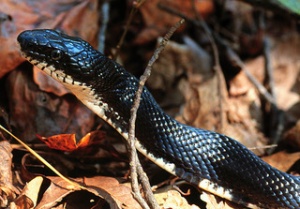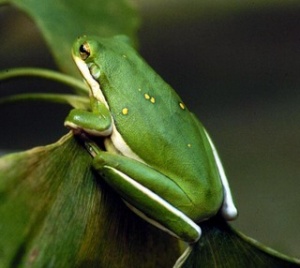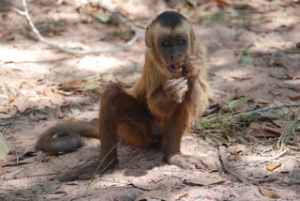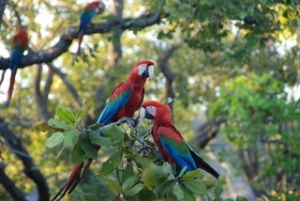Biology of the Vertebrates
EEB 2214
Fall 2008
This course will cover the diversity of vertebrates and the evolution of form and function within this group.
Meetings: Tuesdays and Thursdays, 12:30-1:45 in BSP130
Textbook: Pough F. H., C. M. Janis, and J. B. Heiser. 2005. Vertebrate Life, 7th Edition. Prentice Hall.
Contents
Instructors
Dr. Elizabeth Jockusch
Office: Biology/Pharmacy 305B
Phone: 486-4452
E-mail: elizabeth.jockusch@uconn.edu
Office hours: Tuesdays, 2-3 pm, and by appointment
Dr. Margaret Rubega
Office: Biology/Pharmacy 500
Phone: 486-4502
E-mail: margaret.rubega@uconn.edu
Office hours: by appointment
Maria Pickering (teaching assistant)
Office: Torrey Life Sciences 480
Phone: 486-1882
E-mail: maria.pickering@uconn.edu
Office hours: Thursdays, 3-4 pm, and by appointment
Grading
Exam 1 30% (100 points)
Exam 2 30% (100 points)
Final Exam 40% (133 points)
There will be two one-hour, non-cumulative, exams scheduled during the lecture hour. The two-hour final will be split into two parts: the first part will cover all material since the second exam, and the second part will be a comprehensive (cumulative) exam covering the entire course.
Missed exams and Concerns about Finals![]()
Any student who does not attend an exam and fails to receive permission in advance will receive a 0 for the exam. Approval of any request to miss an exam requires, but is not guaranteed by, verifiable written documentation of the reason. A student who receives approval to miss an exam will, at the discretion of the instructor, either take a make-up exam or have his or her course grade prorated based on performance in the remainder of the course.
Academic integrity
Plagiarism and cheating are violations of the student conduct code, and may be punished by failure in the course or, in severe cases, dismissal from the University. For more information, see Section IV of the Student Conduct Code available at the web site of the Dean of Students.
Disabilities
If you have a disability for which you may be requesting an accommodation, you should contact a course instructor and the Center for Students with Disabilities (Wilbur Cross Building, Room 201) within the first two weeks of the semester:
Vertebrates in the News
Tiktaalik Article
Mammals Threatened with Extinction
New Feathered Dinosaur Discovered
Bat Disease Fungus Identified
Marine Protected Areas Proposed
Link to Tutorial, Practice Quiz, and Study Guide
Go through the powerpointPHYLOGENY TUTORIAL and then test your tree knowledge with this PRACTICE QUIZ![]()
Practice Quiz Answers![]()
Study guide for Exam 1![]()
Practice Multiple Choice Questions![]()
An answer key for exam 1 is posted outside of Dr. Jockusch's Office, BioPharm 305B.
Review Session Information and Additional Office Hours
REVIEW SESSION FOR EXAM 2 will be held on FRIDAY, NOV. 7th, 5:30-6:30, BPB130
- Additional Office Hours on MONDAY, Nov. 10: Maria 12:30-1:30; Dr. Jockusch 4-5pm
Questions (from students) and Answers
what exactly is a pair bond? It is a social association of two individuals for the purposes of reproduction. Thus, two birds who spend time together defending a territory where they will build a nest have a pair bond; two birds who travel together in the same feeding flock in the winter do not.
Were pterosaurs the first vertebrates to gain the ability of powered flight? Yes.
How does the pevlic arrangement differ between ornithischia and saurischia (I understand the pubis orientation but I got confused with pelvis The pelvis consists of three principle bony elements: the ischium, the ilium and the pubis. What differs about the pelvis between ornithischian and saurischian dinosaurs IS the orientiation of the pubis. There is also some difference in the overall shape of the ilium, in that in ornithischian dinosaurs, it has a more elongated anterior (front) projection.
what is the relationship between body size and herbivory (bigger animals are herbivores?) In general, in order to perform successfully as a herbivore, an animal must be relatively large bodied, because plants are difficult to digest, and therefore have to be held in the gut (stored inside the body) for longer. A large gut, with lots of storage space, requires a large container. This does not preclude predators from growing very large -- a blue whale is a predator, not a herbivore --- but it does mean that dedicated herbivores cannot be small.
synapomorphies of birds which distinguish them from arch. and non avian dinosaurs (is that the keeled sternum, pygostyle, etc.?) Synapomorphies of birds include: a pygostyle, fusion of the hand elements, a keeled sternum, and a toothless beak. At one time the list would have included feathers, but we now know that a number of other theropod dinosaurs which we would not consider birds had feathers, so feathers cannot uniquely identify birds among the dinosaurs.
WAIR- i'm confused about how it is a theory of flight; is it that they flap to climb but then they use it to fly? WAIR (Wing-assisted incline running) is an actual behavior exhibited by many species of birds: when they are chased up a slope, they climb or run up it by using their wings in a flapping motion that increases the traction of their feet against the slope. We think about it as a theory of flight in that it illustrates, directly, one way in which we can envision how a ground-dwelling theropod dinosaur could have benefited from limb motions and an increase in the surface area of the limbs; once the motions and the surface area had been enhanced through natural selection (because they were good for tree-climbing) then they were available (and happened also to be useful) for generating lift to get off the ground and fly.
What was the reason for birds having higher body temperatures? I remember the causes of this, such as needing to feed often, but I don’t know what the cause of it is. An excellent question: did the warm body temperatures cause the need to feed often (if you are burning energy all the time, you need to keep feeding the furnace), or did warm body temperatures evolve because of the advantages of being warm all the time for an active predator? We don't know what came first: we know there is an association between being an active predator and being warm-bodied (i.e., able to move around quickly at any time), and between being warm-bodied and high feeding rates. There is also an association between being very warm-bodied (as birds are) and being small (as birds are, in general) that results from the higher rates of heat loss for a small animal than for a large one.
What were the things that helped diversify feeding? I got loss of teeth and flight allowed them to go into any habitat, but I don’t have the third.
An additional factor is that the jaws are covered with a rhamphotheca, a continuously-growing horny covering that is more easily modified in shape than are the underlying bones.
Lecture Schedule, Review Questions, and Video Links
| Date | Instructor | Topic | Readings | |
|---|---|---|---|---|
| Aug. 26 | Jockusch | Vertebrate diversity Salamanders Feeding Marine Iguana Running Komodo Dragon Walking |
--- | |
| Aug. 28 | Jockusch | Chordates and vertebrate origins |
Ch. 1, Ch. 2 | |
| Sept. 2 | Jockusch | Living jawless vertebrates Hagfish Sliming |
pp. 48-53 | |
| Sept. 4 | Jockusch | Early vertebrate fossils |
pp. 43-48, 53-71 | |
| Sept. 9 | Jockusch | Chondrichthyans Shark Mating Whale Shark Feeding Manta Ray Feeding Eagle Ray Feeding |
Ch. 5 | |
| Sept. 11 | Jockusch | Actinopterygians Paddlefish Feeding Moray Eel Eating Listen to a Black Drum |
pp. 124-150 | |
| Sept. 16 | Jockusch | Fish conservation Leafy Seadragon Babies Hatching Mangrove Killifish in Log Pictures of Deep Sea Fishes Bottom Trawling |
pp. 150-155 | |
| Sept. 18 | Jockusch | Fish conservation, Sarcopterygii Guide to Sustainable Seafood Choices-- |
pp. 118-124 | |
| Sept. 23 | Jockusch | The origin of tetrapods |
pp. 196-210 | |
| Sept. 25 | Jockusch | Lissamphibian diversity Salamander Courtship--Headslap Salamander Sperm Transfer Chinese Giant Salamander (Andrias) Frog Eats Frog |
Ch. 10 | |
| Sept. 30 | Jockusch | Exam 1 | ||
| Oct. 2 | Jockusch | Lissamphibian diversity continued Frog defenses-In Snake's Mouth Escape Hatching from Snake Attack |
Ch. 10 | |
| Oct. 7 | Jockusch | Amniote diversity/desert adaptations |
pp. 327-336, 341-374 | |
| Oct. 9 | Jockusch | Evolution of snakes Heat Avoidance in Desert Chameleon Horned Lizard Defense (Spurting Blood!) Snake Jaw in Action |
pp. 336-341 | |
| Oct. 14 | Rubega | Turtles Kemp's Ridley turtle digging a nest Kemp's Ridley turtle laying eggs Kemp's Ridley turtle eggs hatching Kemp's Ridley turtle hatchlings making their way to the sea after hatching |
Ch. 12 | |
| Oct. 16 | Rubega | Diapsids: Archosaurs; Crocodilians Crocodile Parental Care || pp. 397-407 || | ||
| Oct. 21 | Rubega | Archosaurs: Pterosaurs to Dinosaurs |
pp. 407 - 436 | |
| Oct. 23 | Rubega | Dinosaurs II |
pp. 407-436 | |
| Oct. 28 | Rubega | Birds: Avian origins Wing-assisted Incline Running in birds WAIR in a variety of birds |
pp. 426-436 | |
| Oct. 30 | Rubega | Birds: Feeding Crows use cars as a feeding tool! |
pp. 458 -463 | |
| Nov. 4 | Rubega | Birds: Morphology and Reproduction |
pp.443-448, 453-458, 463-478 | |
| Nov. 6 | Rubega | Birds: Reproduction Australian Bowerbird Behavior |
Chap 18 | |
| Nov. 11 | Rubega | Exam 2 *See review session info above* | ||
| Nov. 13 | Rubega | Mammals: Diversity | pp. 519-543 | |
| Nov. 18 | Rubega | Mammals: Morphology and Behavior | Ch. 21 | |
| Nov. 21 | Rubega | Mammals: Primate evolution and human origins | Chapter 24 | |
| Dec. 2 | Rubega | Vertebrate mass extinctions, past and present | 663-671 | |
| Dec. 4 | Rubega | Vertebrate Conservation | pp. 671-687 | |
| Dec. 8 | Final Exam 3:30-5:30 pm (TENTATIVE) |



